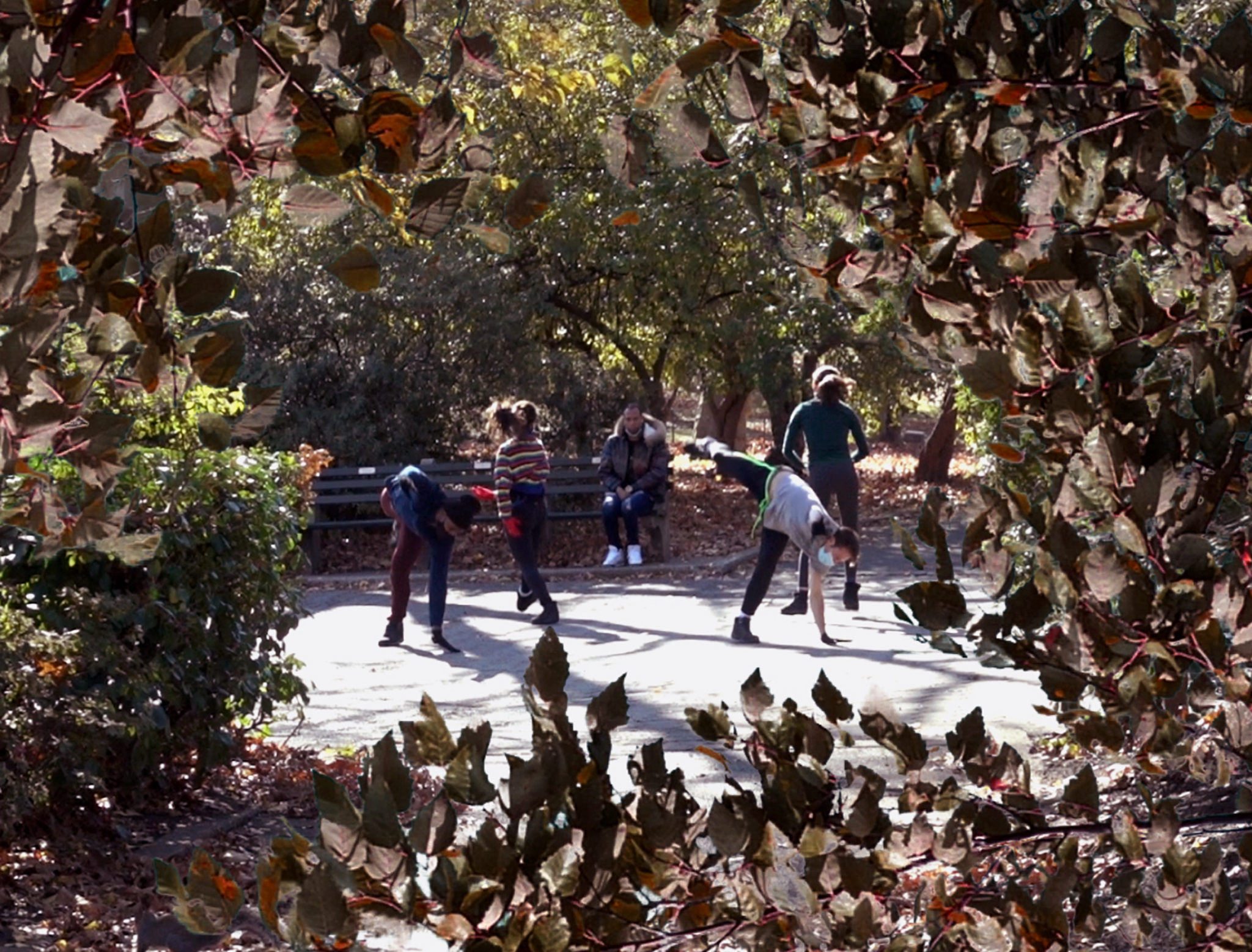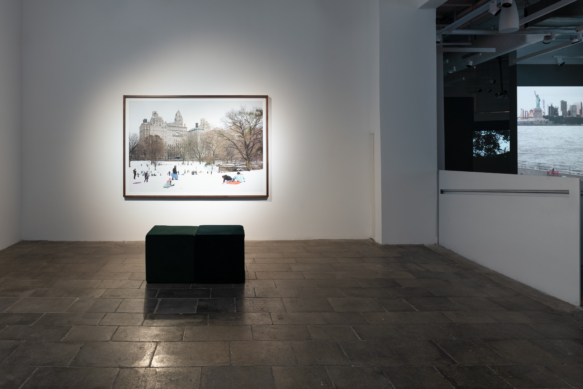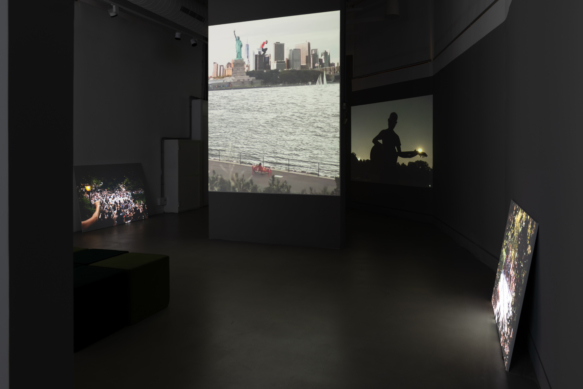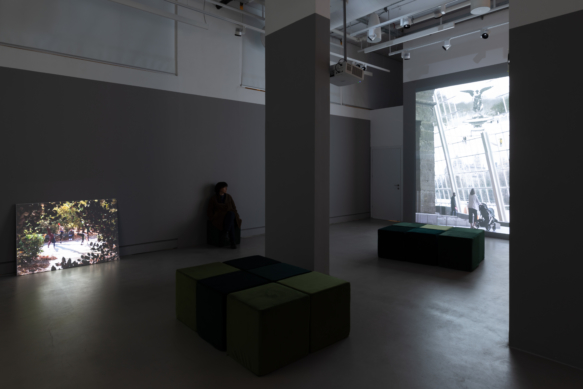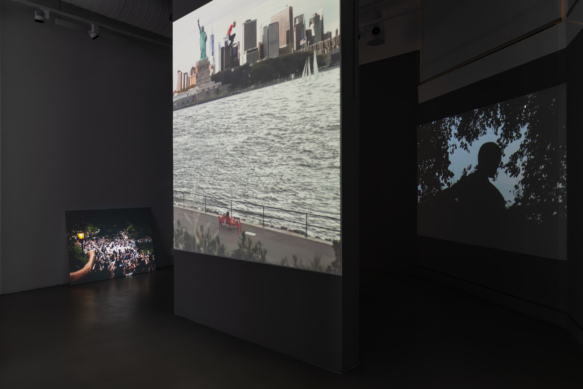“As long as the eastern face of the sky is reddened by the light of the sun setting in the west”
The phrase to which the title of the exhibition alludes appears in the Talmudic discussion regarding the question of when one day ends and the next begins, and its significance in the context of the beginning and ending of Shabbat and holidays. According to Jewish law, as long as the eastern face of the sky is reddened by the light of the sun setting in the west, it is still the same day. The liminal period of time between the end of day and the beginning of night, between sunset and nightfall, is called “dusk” or “twilight” (Heb. bein hashmashot), and since there is fundamental uncertainty as to whether it is part of the day before or the night after, the Sages impose the stringencies of both day and night on it.
Blushing
Blushing is an involuntary physical reaction caused by dilation of the capillaries in the face, leading to its reddening, exposing to the world what we feel. It is a reflexive action of the body, usually a response to stressful situations, often associated with emotions such as anger, anxiety, shyness, or embarrassment, but also with romantic feelings, such as infatuation. The redness is especially noticeable on fair skin and is genetically prevalent among Eastern Europeans.
My Heart is in the East, and I in the Uttermost West
One of the best-known poems in medieval Spanish-Hebrew poetry, written by Rabbi Yehuda Halevi, it reflects not only the intense longing for Zion, but also the prolonged spiritual process, at the end of which the poet is ready to leave all the bounties of Spain in Western Europe, to see the destroyed Temple in the Middle East. The poem has become a symbol of longing and yearning for a homeland, for a long desired place.
Bethesda Fountain
In the heart of Central Park stands one of New York’s largest fountains, with an angel towering to a height of eight feet in its center. The neoclassical bronze sculpture is the only artwork commissioned specifically for the park, featuring the Angel of the Waters with four cherubs beneath it, representing health, purity, temperance, and peace. Designed by Emma Stebbins, the sculpture was unveiled in 1873 and became a landmark. Guitarists, skaters, and lovers regularly crowd in the terrace below. The angel holds a lily in one hand, while the other hand is spread out, either blessing the water or perhaps waiting for us to extend a hand back to it.
Angels in America
A successful 1987 play by Tony Kushner addressing the impact of AIDS on American society. The seven-hour drama was adapted as a two-part play, as well as a film and TV miniseries. At the end of the play, the characters gather under the Bethesda Fountain in Central Park, and the protagonist, who is dying of AIDS, says that they have reached the most beautiful place in the world. The male nurse who accompanies him recounts the legend of the pool, whereby if anyone suffers, in body or soul, he must walk through the fountain to be healed and cleansed of pain. The fountain, they promise, will resume operation, and all the sick residents of the city will return and purge themselves in it.
New York has known quite a few crises in recent years, but the uncertainty brought about by the COVID-19 pandemic reminded many of the city’s veterans of two other times—the period following 9/11 and the height of the AIDS crisis; attacks from within and from without, but mostly a jolting moment that affects everyone, whose consequences, immediate as well as distant, are hard to even imagine.
7 PM
As a token of appreciation for the work of the medical personnel during the COVID-19 crisis, and following the lockdowns that left us in our homes, people around the world started going out at a fixed time every day to applaud the health-care workers. What began in the first lockdowns in Italy with drumming on pots and singing arias from operas, spread to other places in the world following the coronavirus, reached Israel as well, and became a regular ritual in New York, with its crowded buildings and streets and its multiple occupants. Every day at 7 PM, many stood at their windows and clapped. On days when people barely left their homes, 7 PM became a time of gathering, which gave rise to a sense of community and belonging.
8:46
Eight minutes and 46 seconds symbolize the police brutality associated with the murder of George Floyd. Floyd was detained and handcuffed by police in Minneapolis on May 25, 2020. One of the police officers, Derek Chauvin, pressed his knee into Floyd’s neck for many long minutes, even when the latter had already lost consciousness, causing his death. The event was filmed by passers-by, showing the detained Floyd crying helplessly “I can’t breathe,” leading to a massive wave of protests across the United States led by the Black Lives Matter movement. At the center of many of the demonstrations (aka “die-ins”), the protesters sat or lay down side by side for 8:46 minutes with hands raised. Police footage released months later indicated that the duration in question was actually 9 minutes and 29 seconds, but time in 2020 had rules of its own.
The Temple of Dendur, The Metropolitan Museum of Art
In 1967, US President Lyndon B. Johnson received a gift from Egypt—an ancient Egyptian temple dating to the first century BCE. The temple was removed from its original location in Egypt as part of a UNESCO operation to save heritage sites that were in danger of being submerged following the construction of the Aswan High Dam. The temple was housed at the Metropolitan Museum of Art in the 1970s, in a wing constructed especially for it, and features a monumental diagonal glass window, built so that the sun’s rays are scattered through it in a way that mimics the light conditions in the place from which it came. The question of who is allowed to present gifts in the name of his people, which came up regarding quite a few archeological items that found their way to the West, did not tarnish the Temple of Dendur.
Pancho and Lefty
The most popular song by country singer Townes Van Zandt, Pancho and Lefty was recorded in 1972 and reached the top of the charts in 1983 with Willie Nelson and Merle Haggard’s cover. The ballad tells the story of Lefty, a restless youth who leaves his mother in search of his fortune. He meets Pancho, a savage Mexican bandit who dies in the deserts of Mexico after Lefty betrays him. The ballad follows Lefty, who grows old alone in cheap motels in his attempts to reunite with his family and friends, who have moved on with their lives.
July 4th
American Independence Day is celebrated on the date of the Declaration of Independence of the United States on July 4, 1776. It is customarily celebrated with fireworks, picnics, and barbecues in private homes and parks, and with red, white, and blue decorations as the colors of the American flag. The New York fireworks display is the largest in the United States, with over 22 tons of pyrotechnics exploding in the city skies. The fireworks are usually shot above the East River, with additional smaller firework displays in various parks and courtyards. The main New York fireworks display, sponsored by the Macy’s Department Store, has been broadcast live on television since 1976.
King Kong
A fictional giant monster reminiscent of a gorilla, he has appeared in numerous comics and movies in the US during the 20th century. One of the images most identified with King Kong is from a film in which the ape is seen climbing the Empire State Building, one of New York’s iconic buildings, in an attempt to uproot the skyscrapers and destroy the city. In recent years, King Kong’s character has been accused of racism, xenophobia, and reinforcing fear of the black race among white people. The temporal proximity between the Great Depression that struck the United States in 1929 and led to the migration of many workers from the southern states to the big cities, and the film’s release in 1933, only reinforced the fear of those coming from outside the familiar circle. Times of crisis, then as now, have always been moments of xenophobia.
The Flâneur
The flâneur (urban stroller) regards the street as his home, and is in constant motion in the crowd, as if trying to steal their thoughts and secrets. Introduced by poet Charles Baudelaire and further developed by philosopher Walter Benjamin, the figure of the flâneur is a detective-artist traversing the public space, and his passion is not for the intimacy of home, but for the one which takes place outdoors. By observing and listening attentively, the flâneur robs the passersby of their memories, rearranging them so as to make them his own.
Bein Hazmanim
In Jewish Orthodox Yeshivas, a continuous period of study is called “time,” and the school year in the yeshiva is divided into three times (semesters). Between each time and the ensuing one there is a vacation called bein hazmanim (Heb. between the times). This interval is intended for rest from the labor of learning Torah and gathering strength for the next semester. In the secular world, the phrase refers to time intervals, to the period between one event and another.
Read More

